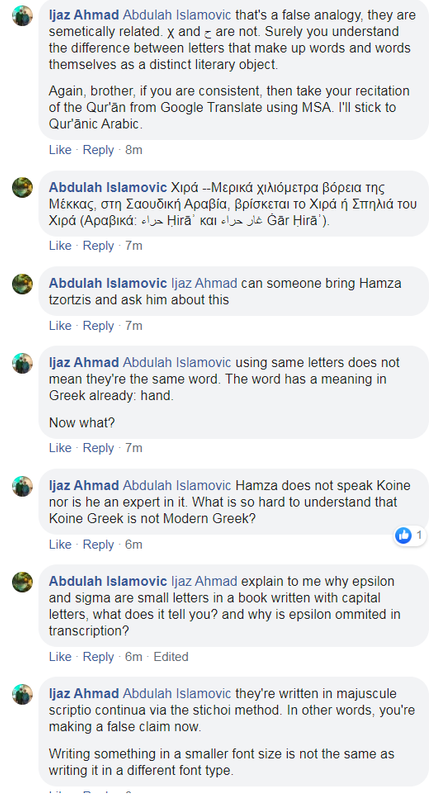As-Salam aleikum wa rahmatullah dear brothers and sister,
I just wanted to say I am sorry for delaying my subsequent parts of my research on Hira in Isaiah 29:12. I was occupied with many other things (especially that it was a period of Ramadan, etc.). Anyway, I can give you a glimpse of what to expect in my upcoming research (the material excerpted from my future book):
In the Greek text of Isaiah 29:12, the illiterate who was given the Book in the place called Hira (as I proved in Evidence #1) is enigmatically addressed as "anthropos" (Gk. ανθρωπου) which means the "man" (some particular person). This Anthropos is mentioned in Balaam’s third and fourth oracle (Numbers 24:7, 17) and the term has a messianic overtones within its context as scholars noted. In the prophecies of Isaiah, this mysterious Anthropos is called otherwise "Glorious", and he is apparently a salvific figure who will come to Zion (Isaiah 35) which is in the "desert" or "wilderness" (used Hebrew 'arabah = Arabia). After exploring extensively Zion’s description, one can conclude without a shadow of doubt that it is a reference to Mecca. Now, in one of the Dead Sea Scrolls documents called 1QM (The War Scroll), a certain passage talks about a warrior who is called "Glorious" and who is a leader of the "army of light" (either angels or believers/saints):
English translation by Geza Vermes
[Rise up, O Hero!
Lead off Thy captives, O Glorious One!
Gather up] Thy spoils, O Author of mighty deeds!
Lay Thy hand on the neck of Thine enemies
and Thy feet [on the pile of the slain!
Smite the nations, Thine adversaries],
and devour flesh with Thy sword!
Fill Thy land with glory
and Thine inheritance with blessing!
That warrior is undoubtedly the same figure described in Isaiah 42:13ff (also Isa 49:1ff), Psalm 45:3-5 and Revelation 19:11-16 (compare these verses and you will notice striking similarities of some details).
Now, the remark about the illiterate being called "Anthropos" and then consequently "Glorious", is extremely important since it is quite consistent with what reported early Muslim exegetes like Ali ibn Rabban (8th century), an ex-Christian scholar influent in Syriac and Hebrew, who was able to identify the name Ahmad in Isaiah 35 (i.e. exactly where Anthropos/Glorious comes to Zion according to the Septuagint). Moreover, al-Tha'labi's Qisas al-Anbiya' (Stories of Prophets), narrates on the authority of Wahb ibn Munabbih, a Jewish scholar, that Isaiah recalled to the Israelites a prophecy about the illiterate prophet Ahmad which in Arabic precisely means "most Glorious", i.e. the one who glorify God in the highest degree (not 'Praised' or 'Praiseworthy' as many Muslims erroneously thinks), whose characteristic is in accordance with the servant of God from Isaiah 42, the very passage where Ka’b cited - according to the report of Ibn Asakir – the words "My servant Ahmad, the Chosen one" !
Now, Philo of Alexandria, in his "De Praemiis et Poenis", quotes the text of Numbers 24:7 (where Anthropos is mentioned), and he says of him the following:
"Some will even flee when no one pursues at all except fear, turning their backs towards the enemy, so as to afford a full mark of shooting, so that it will be very easy for the whole army to fall, being slain to a man;
for a man (anthropos) will come forth [Numbers 24:7 LXX], says the word of God, leading a host and warring furiously, who will subdue great and populous nations, God sending that assistance which is suitable for pious men…” (See The works of Philo Judaeus, vol. 3, trans. C. D. Yonge (London: Henry G. Bohn, 1855), pp. 477-478. Here:
https://archive.org/details/worksofphilojuda03phil/page/476)
By saying "leading a host and warring furiously [i.e. over his enemies]", Philo is indirectly making a reference to Isaiah 42:13 (he will stir up like a man of war, etc.). Notice that the beginning of the text "Some will even flee when no one pursues at all except fear, turning their backs towards the enemy, so as to afford a full mark of shooting, so that it will be very easy for the whole army to fall..." is a curious allusion to the first Muslims (who fought against Quraysh) who were defeated by being attacked from behind (this was a bitter lesson for Muslims because they disobeyed Prophet who commanded them to stay in their position but they didn't listened and consequently lost the battle). However, I'm not sure whether it happened during the Battle of al-Uhud or Battle of al-Badr. Read the rest of the text of Philo in page 478 and you will notice some allusion to the incident of the Jews of Khaibar who refused to accept Mohammed, they betrayed him and tried to kill him, but they were defeated and enslaved which is a reference to Isaiah 42:22-25 and Hosea 9:6-9 where the text according to the Septuagint says that "Mamadius will bury them" making an obvious reference to the massacre of Bani Qurajza (who were capitulated and buried in holes) after God put a judgement upon them so that the death would be a deserved punishment for them.
Moreover, my later research shows that this mysterious "Anthropos" seems to be a reference to the Quranic "Taha", the title of Sura 20 where Allah addresses Prophet Mohammed (SAAW) by this mysterious expression which means "O man" (according to an authoritative Quranic dictionary, here):
https://books.google.fr/books?id=mclrIKdye5QC&pg=PA573&dq=Quran+20+Taha+means+O+man&hl=pl&sa=X&ved=0ahUKEwiIlILh9tDiAhUSmRQKHdx4AtMQ6AEIMTAB#v=onepage&q=Quran%2020%20Taha%20means%20O%20man&f=falseSee also this video below where it is explained that even in Hebrew and Syriac language, the term taha means "O man"(fragment of the video 7:43-8:42 min.):
https://www.youtube.com/watch?v=v_HtiVOJlow&t=8sNow, the Samaritan tradition call the "prophet like Moses" from Deuteronomy 18:18 by the name "Tahab" making it strikingly similar to the Quranic "Taha". Coincidence? Read also the next verses that comes immediately after the word Taha (O Man): "We have not sent down to you the Qur'an that you be distressed"
https://quran.com/20. This makes a parallel allusion to the Book given to the illiterate in Isaiah 29:12 who according to LXX is called the "man" (Anthropos). What is surprising also is the thematical agreement of later verses in Surat Taha. For example, it recalls the case of Moses (AS) and how he was sent to Pharaoh in Egypt. If you read Isaiah 30, you will notice the reference to Pharaoh and Egypt, magicians, etc. Again, is it a coincidence ?
Can you handle all of these crazy connections ? Actually, there are more details… there are TOO MUCH exciting details that must be investigated.
Alhamdulillah for all!




